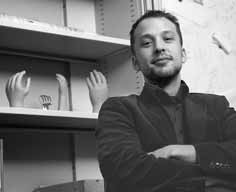Marc Abrahams's Blog, page 531
December 4, 2012
Professor Haans’ less rubbery hands
 Since first described by Botvinick & Cohen in 1998, The Rubber Hand Illusion (RHI) has been extensively investigated. But few researchers have explored the possibility of enhancing the illusion by making the fake hand a little less, shall we say, ‘rubbery’.
Since first described by Botvinick & Cohen in 1998, The Rubber Hand Illusion (RHI) has been extensively investigated. But few researchers have explored the possibility of enhancing the illusion by making the fake hand a little less, shall we say, ‘rubbery’.
Prompting Antal Haans, assistant professor of environmental psychology in the Human-Technology Interaction group at Eindhoven University of Technology, the Netherlands, to perform an experiment (along with co-investigators Wijnand A. IJsselsteijn, and Yvonne A.W. de Kort).
Their paper: ‘The effect of similarities in skin texture and hand shape on perceived ownership of a fake limb’ was published in Body Image (An International Journal of Research), Volume 5, Issue 4, December 2008, Pages 389-394,
“In the rubber-hand illusion (RHI), people attribute an artificial object to their own body. In the present study, we investigate the extent to which RHI is affected by visual discrepancies between the artificial object and a human hand. We tested Armel and Ramachandran’s (2003) hypothesis that people will experience a stronger RHI when the artificial object is a skin-like textured sheet instead of a tabletop. We did not find support for their hypothesis, but the strength of the RHI diminished when the texture of a hand-shaped object did not resemble the human skin (manipulated by putting a white glove over the cosmetic prosthesis). We provide an alternative explanation for this finding, based on a skill-based sensorimotor account of perceived body ownership. Such an explanation supports Armel and Ramachandran’s more general claim that discrepancies in the nature of expected and felt touch diminish the RHI.”
The paper is available for $31.50 to non-subscribers (Taxes may be applicable.) Or, if you prefer, a substantially similar article can be read in full here – free of charge.

Theory of Almost Everything: Quantum-Structured Lizard Communities
Some reports explain more than other reports do. Here’s an example:
“Quantum Probabilistic Structures in Competing Lizard Communities,” Diederik Aerts, Marek Czachor, Maciej Kuna, Barry Sinervo, Sandro Sozzo [pictured here], arXiv:1212.0109, December 1, 2012. The authors, at Brussels Free University, Belgium, Politechnika Gdanska, Poland, and the University of California, Santa Barbara, USA, explain:
“Almost two decades of research on the use of the mathematical formalism of quantum theory as a modeling tool for entities and their dynamics in domains different from the micro-world has now firmly shown the systematic appearance of quantum structures in aspects of human behavior and thought, such as in cognitive processes of decision-making, and in the way concepts are combined into sentences. In this paper, we extend this insight to animal behavior showing that a quantum probabilistic structure models the mating competition of three side-blotched lizard morphs. We analyze a set of experimental data collected from 1990 to 2011 on these morphs, whose territorial behavior follows a cyclic rock-paper-scissors (RPS) dynamics. Consequently we prove that a single classical Kolmogorovian space does not exist for the lizard’s dynamics, and elaborate an explicit quantum description in Hilbert space faithfully modeling the gathered data. This result is relevant for population dynamics as a whole, since many systems, e.g. the so called plankton paradox situation, are believed to contain elements of cyclic competition.”
(Thanks to investigator Jonathan Dowling for bringing this to our attention.)

The cosmic finger of friendship
Investigator Ian Davis wrote us today to reminisce about the coining here, in 2001, of the phrase “The Cosmic Finger of Friendship”. A year later, the phrase and the photograph that inspired it (reproduced here) made it onto the cover of the magazine.

December 3, 2012
Why was Mrs Thatcher interrupted so often in interviews?
 Prime minister Margaret Thatcher‘s masterful way of handling interruptions inspired one psychologist to study, intently, how she did it. As this scholar communicated his findings to the public, other scholars, with different views, interrupted him – and he them.
Prime minister Margaret Thatcher‘s masterful way of handling interruptions inspired one psychologist to study, intently, how she did it. As this scholar communicated his findings to the public, other scholars, with different views, interrupted him – and he them.
Geoffrey Beattie [pictured here] is now a professorial research fellow of the Sustainable Consumption Institute at the University of Manchester. Or rather, was — he reportedly was sacked after I wrote this column but just before it was published.
In 1982, while at the University of Sheffield, Beattie published two studies about Thatcher….
So begins this week’s Improbable Research column in The Guardian.

A look back at the Lettvin-Leary debate
It’s always fun, in a peculiar way, to look at video of the debate between Jerry Lettvin and Timothy Leary, held in 1967 at MIT, and broadcast on public television station WGBH. This was about whether it was a bad idea or a good idea to use psychedelic drugs to “drop out” of mainstream society. Jerry Lettvin was recruited for this at the last moment. History has more or less neglected that Jerry and Tim were good friends, as well as public figures who each loved to perform for any audience. In the video, Tim talks for the first 30 minutes, then Jerry has his say. The debate’s most famous moment happens around the 41-minute mark:
BACKGROUND:

Invention: a desk for people who sit on a toilet
The toilet users rolling desk in an invention for persons who wish to work and drink coffee whilst sitting on the throne. The idea is on file with the US patent office:
“Toilet users rollable desk,” US patent application #20120223627 A1, Brian Wylie and Cameron Wylie, filed March 4, 2011. Details:
“A toilet users rollable desk for A compact personal office desk for the commode user. The toilet users rollable desk generally includes A desk that provides the toilet user with a space between the knees and legs to read, write, use the computer and store personal items as well as a shelf to place coffee or nourishment. The toilet users rollable desk is also able to store toilet tissue, hold reading material and be conveniently moved in front of the commode user for all processes to be best utilized in the large, average or small toilet commode area.”
BONUS: New Scientist reports about an unrelated device that combines a water tap and hand dryer.

December 2, 2012
Nonstraightforwardness – an exploration
 Recent research has suggested that issuing vague or equivocal public statements can sometimes be advisable for a corporation undergoing a crisis. But previous academic work had also studied a broadly similar concept, called ‘Nonstraightforwardness’. A team of investigators lead by Susan Kline (Associate Professor and Associate Director for Undergraduate Studies at The Ohio State University) conducted two experiments to elucidate its effects. The experiments (#1 in particular) showed that :
Recent research has suggested that issuing vague or equivocal public statements can sometimes be advisable for a corporation undergoing a crisis. But previous academic work had also studied a broadly similar concept, called ‘Nonstraightforwardness’. A team of investigators lead by Susan Kline (Associate Professor and Associate Director for Undergraduate Studies at The Ohio State University) conducted two experiments to elucidate its effects. The experiments (#1 in particular) showed that :
“As predicted, equivocal messages were both viewed as appropriate messages to use and associated with two measures of corporate reputation in avoidance-avoidance situations.”
“By contrast, nonequivocal messages were viewed as more appropriate to use and associated with corporate reputation in non—avoidance-avoidance situations.”
(* see note below)
Non-subscribers to the journal Communication Research, which (“…takes you to the cutting-edge of research and theory in all areas within the field of communication.”) may purchase the article for US$25.00
Non-subscribers to the journal Communication Research may also not purchase a very similar article here :
Notes:
• Improbable attempt at clarification #1
Those who receive communications may sometimes get the impression that the communicator is, in reality, trying to avoid saying something. If the communicator is aware of this, he/she may feel that a better approach would be to avoid being seen as avoiding something – and thus they take the avoidance-avoidance route. In other words, a straightforward communication may be more beneficial. Conversely, if a communicator chooses instead to stick to a non-straightforward path then this can be seen as a non-avoidance-avoidance methodology.
• Improbable attempt at clarification #2
Sometimes it’s best to tell things the way they are – sometimes it’s not.
• “Avoidance-Avoidance Goal Conflict Theory” was first described by Lewin, K. (1938) in ‘The conceptual representation and measurement of psychological forces.’ Contributions to Psychological Theory, 1, (serial no. 4). Professor Lewin also created the concept of “Vector Psychology” which pointed out that psychological “forces” and “force fields” don’t really have “directions” in the Euclidian sense. In other words they can’t be pinpointed in 3-D space. Or found on a map.
“Direction in psychology cannot be defined as physical direction and cannot be determined by Euclidian geometry. A geometry applicable in psychology is that of hodological space.”
The professor was also noted for his single-handed development of
Hodological psychology. And Genidentity.

Making cheese from humans’ foot, nose, armpit bacteria
“Make hay while the sun shines, but make cheese from places where it does not” is the unstated them of a project described in Christina Agapakis‘s Harvard PhD Thesis (and described more colorfully on her web site):
“Descriptions of human body odors often overlap with those of cheese; Propionibacterium used to make Swiss cheese is a major contributor to the smell of the human armpit and Limburger cheese offers a remarkably close substitute for the smell of human feet, an attractant for certain species of mosquito…
“we sought out to make cheeses with starter cultures isolated from the human body. Swabs from hands, feet, noses, and armpits were inoculated into fresh, pasteurized, organic whole milk (figure 5.4) and incubated overnight at 37° Celsius. The milk curds were then strained and pressed, yelding unique smelling fresh cheeses (figure 5.5). Eight cheeses were produced in total for further study.”
It cites the Ig Nobel Prize-winning study
Knols, B G and De Jong, R, Limburger cheese as an attractant for the malaria mosquito Anopheles gambiae s.s. Parasitology today (Personal ed.) 12 (4), 159 (1996).
(Thanks to investigator Todd Ellner for bringing this to our attention.)
BONUS: A video of Ig Nobel winner Bart Knols and cheese (and other things):

“First we get proof of heaven; now the secret of immortality”
A celebrated “immortal” jellyfish dies a thousand deaths, so to speak, when Paul Raeburn gives it a good look in the Knight Science Journalism tracker. Raeburn writes:
Only a few weeks after Newsweek and Simon & Schuster gave us proof of heaven, The New York Times now offers us immortality in the form of an article entitled ”Can a Jellyfish Unlock the Secret of Immortality?”
It is now online and will appear as the cover story in the Dec. 2 New York Times Magazine….
It’s a fascinating creature. But the problem with this story is that much of what is reported is highly improbable, even unbelievable. And the writing is discursive to a fault. We learn far more than we need to, for example, about the principal researcher’s avocation as a songwriter and karaoke singer.
The article’s biggest failing, however, is that the entire premise of the story is undermined in the middle of the piece and again in the last few grafs, with two revelations likely to leave readers flipping back to the beginning to figure out how they were so badly misled….
BONUS: Jonathan Eisen serves up a few notes on the matter.

The King’s Birthday Vasectomy Festival: 25th Anniversary!
December 5 will be the 25th anniversary of the historic 1987 King’s Birthday Vasectomy Festival, which may have been the most biomedically intriguing King’s Birthday Vasectomy Festival of them all:
“No-Scalpel Vasectomy at the King’s Birthday Vasectomy Festival,” by Apichart Nirapathpongporn, Douglas H. Huber and John N. Krieger, The Lancet, no. 335, 1990, pp. 894- 895. The festival took place, appropriately, in Bangkok.
BONUS: CNN’s report about the 1997 festival
BONUS: This year the King’s birthday falls within Asian Pacific Digestive Week
BONUS (possibly not related): A look back at Thailand’s epidemic of penile amputations

Marc Abrahams's Blog
- Marc Abrahams's profile
- 14 followers







